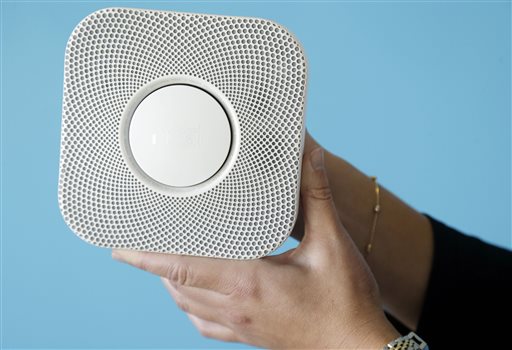(AP) Google builds a ‘Nest’ for future of smart homes
By MICHAEL LIEDTKE
AP Technology Writer
SAN FRANCISCO
When our Internet-connected gadgets and home appliances all learn to talk to each other, Google wants to be at the center of the conversation.
This imagined future is still a few years away, but Google is already preparing with its $3.2 billion acquisition of high-tech thermostat and smoke-detector maker Nest Labs.
The surprise deal announced earlier this week will provide Google Inc. with more tools to build a valuable hub for homes. It’s a world of network-tethered toasters and tea kettles, or a so-called “Internet of Things,” that is destined to reshape society, experts say, in the same way that smartphones have done in the seven years since Apple Inc. unveiled the iPhone.
The research firm Gartner Inc. expects more than 26 billion objects to be connected to the Internet by 2020, a figure that doesn’t include personal computers, smartphones or tablets. That would be a nearly 30-fold increase from roughly 900 million Internet-connected things in 2009.
Google established itself as an instrumental player in smartphones with the 2008 release of Android, a free operating system that runs on more mobile devices than any other piece of software. Now, the company is gearing up for the advent of the smart home with the help of Nest Labs, a 300-employee company started in Palo Alto, Calif. less than four years ago. Tony Fadell, Nest’s founder, is an Apple veteran who helped design the iPod and the iPhone.
As influential as smartphones have become, their role in understanding people’s habits and preferences could be eclipsed once everything in the home has a computer chip and is connected to the Internet.
Nest Labs quickly won over gadget lovers with its 2011 release of an Internet-connected thermostat that learns to cool and heat homes to suit the needs of the inhabitants. Late last year, the company followed up with a smoke and carbon-monoxide detector equipped with voice technology and the ability to communicate with the company’s thermostat. Nest hasn’t said how many of its devices have been sold, though analysts believe they are in just a small fraction of homes. The products have only been available in the U.S., Canada and the United Kingdom.
Google hasn’t disclosed its specific plans for Nest, but analysts anticipate an entire line of Internet-connected home products will be coming to countries around the world. Some of those Nest devices could be melded with existing Google services in an effort to make people’s lives easier. Such a move also would provide Google with the means to gather more insight that could be used to sell the digital advertising that generates most of the company’s revenue.
In a blog post about the Google acquisition, Nest Labs co-founder Matt Rogers promised that customers’ personal information will only be used for “providing and improving Nest’s products and services. We’ve always taken privacy seriously and this will not change.”
But that pledge won’t preclude Google from incorporating its services with Nest’s products, said Gartner analyst Angela McIntyre. For instance, Google already makes a digital assistant called “Google Now” that strives to learn what its users like and where they tend to go so it can provide helpful information without prompting. McIntyre believes Nest’s products will teach Google Now to become more helpful so it can increasingly take over more of the mundane tasks in people’s lives.
Google also could plug its digital mapping software into Nest products so it could learn the layout of a home, said Brian Proffitt, a technology analyst who is also a management instructor at the University of Notre Dame. That knowledge could then be deployed to delegate such household chores as vacuuming to a robot that would be able to rely on the interior maps to navigate its way through an entire home without human help, Proffitt said.
A Google division run by Android creator Andy Rubin is working on various ideas for robots, though the Mountain View, Calif., company hasn’t shared many details about its goals. Google’s expansion into robotics is also being bolstered by a spate of acquisitions that included the recent purchase of Boston Dynamics, a U.S. military contractor that has already built a variety of contraptions that can be programmed to run at rapid speeds, leap high into the air and climb rocky terrains.
Even as it explores various technological frontiers, Google still makes most of its money from advertising tied to search requests. Acquiring and developing products with Internet connections and environmental sensors can only help Google get an even better grasp on people’s interests.

COMMENTS
Please let us know if you're having issues with commenting.